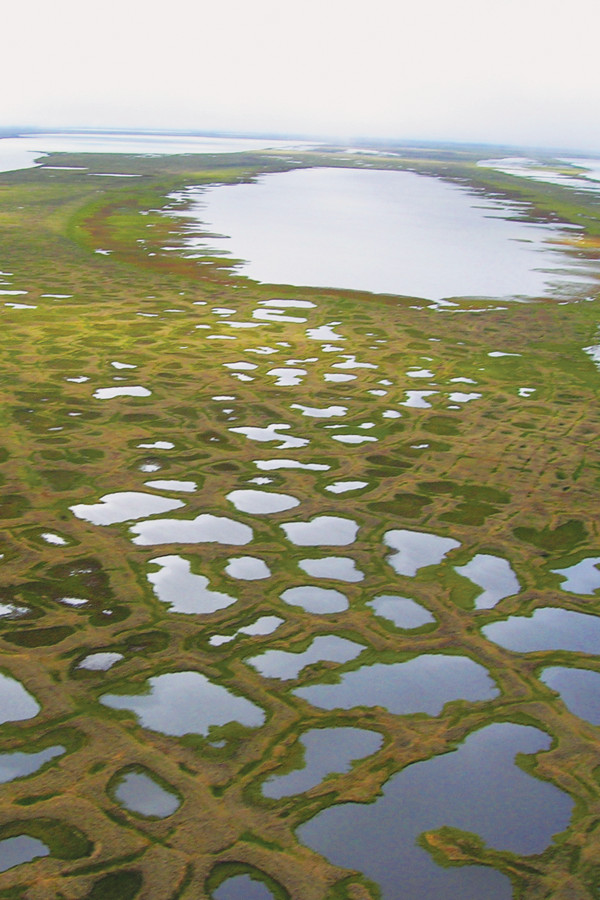
by Timothy Oleson Wednesday, September 3, 2014

Arctic permafrost, or thermokarst, lakes like these release methane, but new research suggests that on millennial timescales, they act as net carbon sinks as decaying organic matter is buried in lake sediments. Credit: UAF/Katey Walter Anthony.
From Antarctica to the Arctic; polar caps, permafrost and glaciers to ocean-rafted sea ice; and burly bears to cold-loving microbes, fascinating science is found in every nook and crevasse of Earth’s cryosphere, and new findings are announced often. Here are a few of the latest updates.
Arctic lakes that form as permafrost warms are typically thought of as net greenhouse gas emitters due to methane-generating microbes that consume thawing organic matter. That may be true on short timescales, but over millennia, such lakes appear to be net carbon sinks, according to a new study published in Nature. Katey Walter Anthony of the University of Alaska at Fairbanks and colleagues studied dozens of former permafrost lakes — which drained naturally and are now filled with peat-like sediments — in northern Siberia. Thawing permafrost does lead to large initial methane releases, but it also stimulates generations of plants to grow and take up carbon dioxide before dying, decaying and contributing to thick stacks of organic-rich sediment in the lakes, they noted. The researchers estimated that the carbon accumulated in such sediments is 1.6 times that released as the lakes formed, and that, after deglaciation commenced in the Arctic roughly 15,000 years ago, the lakes have contributed to net climate cooling since about 5,000 years ago.
Geothermal heat rising through the ground is part of what causes melting at the base of glaciers and ice sheets, which in turn allows the ice to flow faster. Scientists looking to better understand the behavior of the West Antarctic Ice Sheet (WAIS) — thought to be especially vulnerable to melting — have now mapped geothermal heat flux beneath a large, fast-moving portion of the WAIS called Thwaites Glacier. Led by Dustin Schroeder of the University of Texas at Austin, the team collected radar soundings over the area during an airborne survey. After subtracting other heating effects, such as friction between the glacier and the ground, the team quantified the distribution of basal meltwater beneath the glacier due to geothermal heating. In Proceedings of the National Academy of Sciences, they reported that melting of Thwaites Glacier due to geothermal heat was unevenly distributed, but that the positions of large melt channels correlated with areas of high heat flow, including near Mount Takahe volcano.
Meanwhile, scientists studying meltwater beneath outlet glaciers near Greenland’s coast reported in Nature Geoscience that large volumes of meltwater sometimes refreeze, impacting how the overlying ice flows. Using airborne radar sounding and gravity data, Robin Bell of Columbia University’s Lamont-Doherty Earth Observatory and colleagues observed that large pockets of refrozen basal meltwater, which expand and give off heat as they refreeze, had caused substantial deformation in, and possibly warmed the layers of ice above, the pockets. In particular, they noted that the fastest-flowing areas of Greenland’s Petermann Glacier coincide with these refrozen ice pockets.
In another study of Greenland’s ice sheet published in Nature Geoscience, Marie Dumont of France’s National Center for Meteorological Research in Grenoble and colleagues found that the previously observed darkening of surface snow on the ice sheet since 2009 is likely due to an increase in dust and other impurities falling on the snow. The researchers suggested that this material was originating “from snow-free areas in the Arctic that are experiencing earlier melting of seasonal snow cover as the climate warms.” Dust and impurities absorb solar radiation and decrease the albedo (a measure of reflected sunlight) of fresh snow on the ice sheet, thus contributing to warming of the ice. Based on satellite data and modeling, the team estimated that the dust-induced albedo reduction leads to a loss of 27 gigatons of water — roughly the mass of water in Lake Champlain, on the border of Vermont and New York state — per year from the ice sheet’s surface, and also causes granules of snow on the ice sheet to grow, further reducing the albedo.
© 2008-2021. All rights reserved. Any copying, redistribution or retransmission of any of the contents of this service without the expressed written permission of the American Geosciences Institute is expressly prohibited. Click here for all copyright requests.